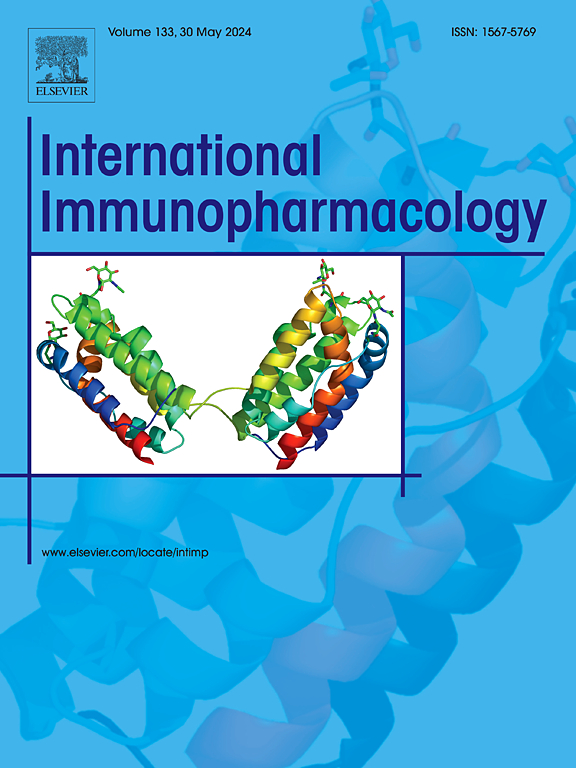Lycium barbarum glycopeptide attenuates intracerebral hemorrhage-induced inflammation and oxidative stress via activation of the Sirt3 signaling pathway
IF 4.8
2区 医学
Q2 IMMUNOLOGY
引用次数: 0
Abstract
Background
Intracerebral hemorrhage (ICH) is a severe neurological condition characterized by high morbidity and mortality rates, with no effective treatment currently available. Lycium barbarum glycopeptide (LbGP), derived from the further purification of Lycium barbarum polysaccharides (LBP), has demonstrated anti-inflammatory effects, suggesting its potential as a therapeutic agent for ICH. However, the role and mechanisms of LbGP in ICH remain unclear. This study aimed to investigate the effects of LbGP on ICH and its underlying mechanisms.
Methods
A collagenase injection-induced mouse model of ICH was used to evaluate the therapeutic effects of LbGP. Mice were treated with varying doses of LbGP, and outcomes were assessed based on hemorrhage volume, neurological function, inflammation, and oxidative stress markers. Apoptosis was analyzed using TUNEL staining. Mechanistic studies focused on mitochondrial acetylation homeostasis and the expression of Sirt3, a mitochondrial deacetylase. Statistical analyses were performed using one-way ANOVA with Tukey's post hoc tests.
Results
LbGP administration reduced hemorrhage volume and improved neurological function in a dose-dependent manner. It significantly decreased pro-inflammatory cytokines (IL-18, TNF-α, IL-1β) and oxidative stress markers (malondialdehyde and reactive oxygen species) while increasing superoxide dismutase activity and total antioxidant capacity. LbGP treatment also mitigated apoptosis and promoted mitochondrial acetylation homeostasis. Mechanistically, LbGP upregulated mitochondrial Sirt3 expression, and blocking Sirt3 disrupted mitochondrial acetylation homeostasis, resulting in increased inflammation and oxidative stress.
Conclusions
LbGP alleviates inflammation and oxidative stress in hemorrhagic brain injury by activating Sirt3 and maintaining mitochondrial acetylation homeostasis. These findings highlight the therapeutic potential of LbGP in treating ICH, providing a foundation for further clinical applications.

求助全文
约1分钟内获得全文
求助全文
来源期刊
CiteScore
8.40
自引率
3.60%
发文量
935
审稿时长
53 days
期刊介绍:
International Immunopharmacology is the primary vehicle for the publication of original research papers pertinent to the overlapping areas of immunology, pharmacology, cytokine biology, immunotherapy, immunopathology and immunotoxicology. Review articles that encompass these subjects are also welcome.
The subject material appropriate for submission includes:
• Clinical studies employing immunotherapy of any type including the use of: bacterial and chemical agents; thymic hormones, interferon, lymphokines, etc., in transplantation and diseases such as cancer, immunodeficiency, chronic infection and allergic, inflammatory or autoimmune disorders.
• Studies on the mechanisms of action of these agents for specific parameters of immune competence as well as the overall clinical state.
• Pre-clinical animal studies and in vitro studies on mechanisms of action with immunopotentiators, immunomodulators, immunoadjuvants and other pharmacological agents active on cells participating in immune or allergic responses.
• Pharmacological compounds, microbial products and toxicological agents that affect the lymphoid system, and their mechanisms of action.
• Agents that activate genes or modify transcription and translation within the immune response.
• Substances activated, generated, or released through immunologic or related pathways that are pharmacologically active.
• Production, function and regulation of cytokines and their receptors.
• Classical pharmacological studies on the effects of chemokines and bioactive factors released during immunological reactions.

 求助内容:
求助内容: 应助结果提醒方式:
应助结果提醒方式:


